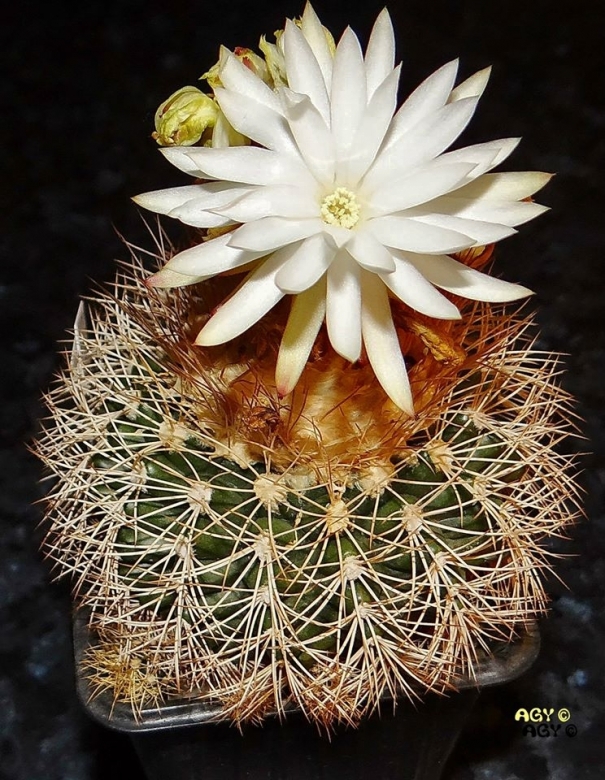
Discocactus zehntneri subs. boomianus Photo by: Agócs György
White night-bloomig flowers at Rebutialand cactus collection Demjén, Hungary.
Origin and Habitat: Geographic coordinates 11º 29 'S and 41 ° 20' W and 11º 28 'S 41º 22' W in the Morro do Chapéu municipality, Chapada Diamantina, Bahia, Brazil. Plants are scattered in spotted population, individuals have varying degrees of aggregation and apparent spatial structure.
Altitude range: The altitude ranges between 700 and 900 meters and slopes between 2 and 9 degrees.
Habitat and origin: Discocactus zehntneriSN|12925]]SN|12925]] subs. boomianus grows in tropical semi-arid region with hot summers where it forms large clusters, and usually it is found growing on sandstone outcrops in sandy terrain together with low size xerophytic flora. Annual average temperatures ranges from 20 to 22 ° C and annual rainfall from 600 to 700 mm. This species presents both sexual and asexual reproductive systems. Plants offsets from the base to form little clusters, the sprouts remain attached close to the mother plants, but after some time most of them start producing roots becoming fully independent, and mingle with seed-grown individuals, which are also heavily concentrated around the mother plants, due to the dispersion pattern of its seeds. This night-blooming species is pollinated by hawkmoths and Coleoptera.
Synonyms:
See all synonyms of Discocactus zehntneri
Description: Discocactus zehntneriSN|12935]]SN|12925]] subs. boomianus (firstly described as Discocactus boomianusSN|12925]]SN|12929]] by Buining & Bredero in 1971) is a more or less distinct subspecies of the variable Discocactus zehntneriSN|31325]]SN|12925]]. It is spiner than the type subspecies, with more thinner spines in each areole completely covering the body. But still more importantly, this subspecies has tuberous roots, which D. zehntneri lacks. In Discocactus, tuberous roots are otherwise only found in Discocactus bahiensisSN|31323]]SN|31323]] and in the newly described Discocactus petr-halfariSN|12925]]SN|31325]]. Discocactus zehntneriSN|12929]]SN|12925]] subs. boomianus has dark tipped yellowish spines, small body, ribs broken up in tubercles, and red fruits, and eventually offsets from the base to form little clusters, and produces in culture just as many offsets as Discocactus araneispinusSN|12925]]SN|12935]]). Mature individuals possess a small cephalium, a structure formed by trichomes (woolly hairs) from which emerge the tubular, white, sweetly scented flowers.
Derivation of specific name: boomianus For Dr. Boudewijn K. Boom (1903–1980), Dutch horticultural botanist at Wageningen University.
Areoles: Oval. About 9-10 per ribs in plants with cephalium.
Stem: Up to 6(-8) cm tall and 10(-14) cm wide, green to dark green, with 16-20 bumpy ribs.
Radial spines: 10 to 14, more or less arranged in comb-formation, recurved backwards to the plant, at first yellow to light brown, darker tipped, later greyish, ca. 3 cm long.
Central spines: Absent, occasionally 1 , up to 3.5-4 cm long. On the top of the plant the central spines are longer and upright.
Cephalium: Creamy-white, grayish/white to very pale brownish.
Flowers: Night- blooming, white, 9 cm long. The position of the stigma is half-way up the secondary stamens.
Fruits (Berries): Indehiscent ranging from bright red to white. The fruits have an average of 118 (± 45) seeds.
Seeds: Globular tuberculate, ca.1.34 mm wide, 1.48 mm high, and 1,15mm thick.
Subspecies, varieties, forms and cultivars of plants belonging to the Discocactus zehntneri group
 Discocactus zehntneri Britton & Rose: Usually globose and completely covered in white thin, needle-like spines, the flower is about 3 cm long and the fruit are red (Origin: Sentocé)
Discocactus zehntneri Britton & Rose: Usually globose and completely covered in white thin, needle-like spines, the flower is about 3 cm long and the fruit are red (Origin: Sentocé) Discocactus zehntneri subs. albispinus (Buining & Bredero) P.J.Braun & Esteves: has larger flattend stems. Spines fewer, longer, white and more recurved. Distribution: South-east of Sento Sé in the Serra do San Francisco, Bahia.
Discocactus zehntneri subs. albispinus (Buining & Bredero) P.J.Braun & Esteves: has larger flattend stems. Spines fewer, longer, white and more recurved. Distribution: South-east of Sento Sé in the Serra do San Francisco, Bahia. Discocactus zehntneri subs. araneispinus (Buining & Bredero) P.J.Braun & Esteves: It has 10 to15 flexible, interlacing spines up to 1-2 cm long, that are pectinate, flexible, creamy white or whitish-yellow with dark tips, becoming pale-brown to whitish, recurved backwards, sitting on the plant like spiders.
Discocactus zehntneri subs. araneispinus (Buining & Bredero) P.J.Braun & Esteves: It has 10 to15 flexible, interlacing spines up to 1-2 cm long, that are pectinate, flexible, creamy white or whitish-yellow with dark tips, becoming pale-brown to whitish, recurved backwards, sitting on the plant like spiders. Discocactus zehntneri subs. boomianus (Buining & Bredero) N.P.Taylor & Zappi: Usually disk -shaped, with dark tipped yellowish spines, the flowers are up to 9 cm long. It has tuberous roots. (Origin: Morro do Chapéu municipality, Chapada Diamantina, Bahia)
Discocactus zehntneri subs. boomianus (Buining & Bredero) N.P.Taylor & Zappi: Usually disk -shaped, with dark tipped yellowish spines, the flowers are up to 9 cm long. It has tuberous roots. (Origin: Morro do Chapéu municipality, Chapada Diamantina, Bahia) Discocactus zehntneri subs. buenekeri (W.R.Abraham) P.J.Braun & Esteves: This species does share the complex commonality of tuberculate ribs and basal offsetting, but its white, club-shaped fruit does not fit with the dark red , much elongated and slender fruit of the other taxa.
Discocactus zehntneri subs. buenekeri (W.R.Abraham) P.J.Braun & Esteves: This species does share the complex commonality of tuberculate ribs and basal offsetting, but its white, club-shaped fruit does not fit with the dark red , much elongated and slender fruit of the other taxa. Discocactus zehntneri subs. horstiorum (P.J.Braun) P.J.Braun & Esteves: Slow growing form (Origin: near Minas do Mimosa, Moreno, Sierra do Espinahaco, Bahia )
Discocactus zehntneri subs. horstiorum (P.J.Braun) P.J.Braun & Esteves: Slow growing form (Origin: near Minas do Mimosa, Moreno, Sierra do Espinahaco, Bahia )
Bibliography: Major references
1) Willy Cullmann, Erich Götz (Dozent Dr.), Gerhard Gröner “The encyclopedia of cacti” Timber Press, 1987
2) Oliveira, João Paulo Loyola “Ecologia de Discocactus zehntneri subsp. boomianus (Cactaceae) em Afloramento Rochoso do Semi-Árido Baiano (Brasil)” Dissertações Mestrado (Pós_Ecologia) http://repositorio.ufba.br/ri/handle/ri/12721 23-Ago-2013
3) Urs Eggli, Leonard E. Newton “Etymological Dictionary of Succulent Plant Names” Springer Science & Business Media, 29 June 2013
4) Cactus and Succulent Journal, 2009 page 48
5) Discocactus Venlo 1980 page35.
6) Succulenta 1971 page26-29.
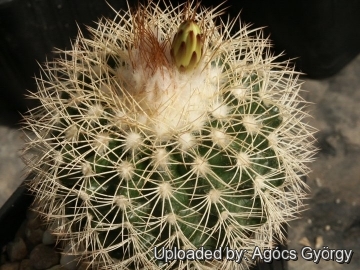 Rebutialand cactus collection Demjén, Hungary. Photo by: Agócs György
Rebutialand cactus collection Demjén, Hungary. Photo by: Agócs György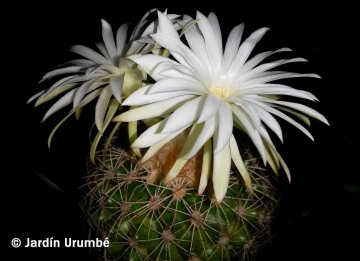 Discocactus zehntneri subs. boomianus Photo by: Alexander Arzberger
Discocactus zehntneri subs. boomianus Photo by: Alexander Arzberger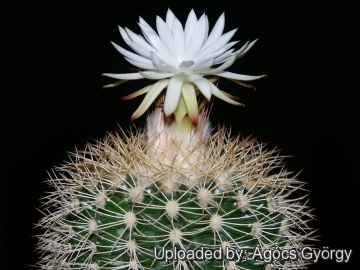 Bloomig habit at Rebutialand cactus collection Demjén, Hungary. Photo by: Agócs György
Bloomig habit at Rebutialand cactus collection Demjén, Hungary. Photo by: Agócs György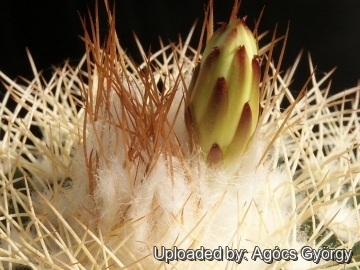 Flower bud at Rebutialand cactus collection Demjén, Hungary. Photo by: Agócs György
Flower bud at Rebutialand cactus collection Demjén, Hungary. Photo by: Agócs György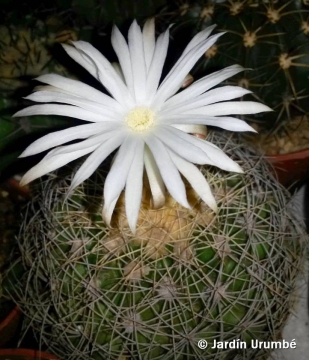 Discocactus zehntneri subs. boomianus Photo by: Alexander Arzberger
Discocactus zehntneri subs. boomianus Photo by: Alexander Arzberger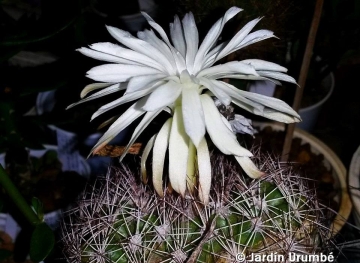 Discocactus zehntneri subs. boomianus Photo by: Alexander Arzberger
Discocactus zehntneri subs. boomianus Photo by: Alexander ArzbergerCultivation and Propagation: Discocactus zehntneri subs. boomianus is one of the easiest species of the genus to grow, but even so it isn't a plants for beginners, in fact collectors consider the Discocactus to be rarities with requires skilful cultivation. it is rather difficult to grow and frost tender, it can’t stand cold, or even fairly cool temperatures and should be kept at above 15° C if grown on its own roots (8°C if grafted). Need full sun or afternoon shade. They are slow growing and very rot prone when kept on their own roots and though they can’t endure long stretches of total dryness, too much water will rot them, as their weak root systems tend to be inefficient at sucking up water from wet soil. They generally resent being repotted and can take a long time to establish. When grown to maturity, however, it possess an exotic look shared by no other cacti, and it generally attract a lot of attention.
Propagation: Seed or cuttings. Young seedlings are generally grafted on a low stock to keep the plant in a good shape.
















